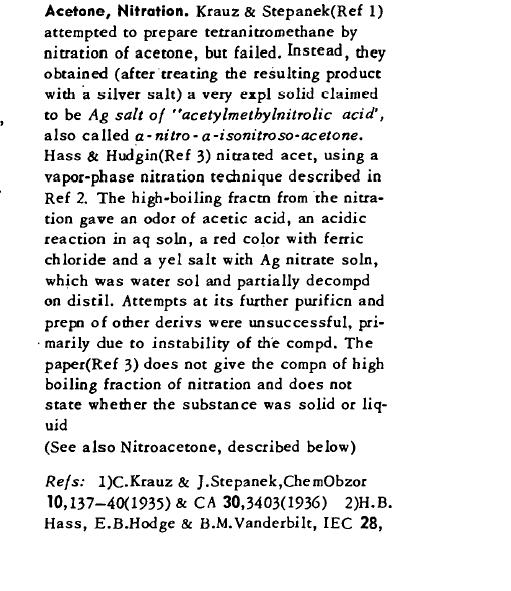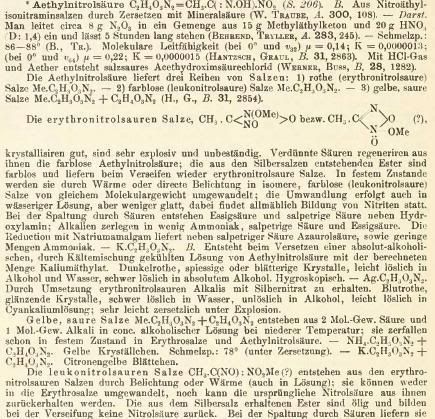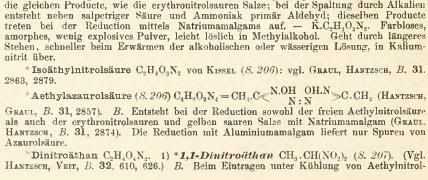The_Davster
A pnictogen
      
Posts: 2861
Registered: 18-11-2003
Member Is Offline
Mood: .
|
|
Silver salt of acetylmethylnitrolic acid
While browsing Federoff, I happened upon this chemical. Not being one to turn away from a funky explosive, I began an experiment...Since the first
referance does not say the 'vapour phase nitration of acetone', I assumed that a standard H2SO4/HNO3 nitration bath could be used. So I get
started, chill the acids to around -10, and begin a slow addition of anhydrous acetone. So while I am waiting for the acids to cool between additions
I browse the forum for the nitration of acetone. I find all sorts of stuff on how it is not possible this way and will likely explode . As soon as I have finished posting this I will go crash the mixture into water... . As soon as I have finished posting this I will go crash the mixture into water...
Anyway, what are everyone's thoughts on this explosive? Would it be possible to react a nitrite with chloroacetone to get nitroacetone, which
would then be treated with AgNO3 to get this explosive, or does this reaction require the direct nitration of acetone and then treatment with AgNO3
to get this explosive?
Anyone have the referances mentioned in the attachment?

|
|
|
Axt
National Hazard
   
Posts: 778
Registered: 28-1-2003
Member Is Offline
Mood: No Mood
|
|
I think that reference is Czechoslovakian (<- that was my spelling word in year 5 at school, so hope I still got it right  ) )
Check vol.1 A84 for more info,
"Was prepd by mixing acetone with nitric acid (d 1.14) and a little fuming HNO3 and allowing the mixt to stand for 8 days at RT. An ether
extraction gave on evaporn some acetylmethylnitrolic acid(Refs 1 & 2)."
1.)Beil 3,621
2)R. Behrend & H. Tryller, Ann283,221- 3( 1894)
These references will be a little more accessible as well. Though you may need ether on account of it being very water soluble. It may be possible to
get a precipitate by straight dilution then precipitation.
Note that d1.14 nitric is only 24% concentration.
A couple related compounds have been brought up before, methylnitrolic acid HON=CH-NO2 and methazonic acid HON=CH-CH2-NO2 both being derived from NM.
So, hear from you again in 8 days 
[Edited on 10-7-2005 by Axt]
|
|
|
The_Davster
A pnictogen
      
Posts: 2861
Registered: 18-11-2003
Member Is Offline
Mood: .
|
|
14mL of 70% nitric acid was added to 20mL of distilled water then more distilled water was added till the volume was 50mLs. 5mL of acetone was added
to this. This occured 8 days before today.
Today the solution was still colorless, but the odour of acetone was nearly gone, there also was another faint different odour. The solution was
divided into 2 ~25mL portions in 50mL beakers. Unfortunatly I have no ether so I could not do an extraction...I guess I am going to have long
evaporation periods. To the first beaker was added a solution of .7g of silver nitrate in 8mL water. No precipitate resulted, I am going to let this
sit and evaporate in the hopes I get a precipitate somewhere down the road. The second beaker I am going to let evaporate for a while before I add
the silver nitrate.
|
|
|
Axt
National Hazard
   
Posts: 778
Registered: 28-1-2003
Member Is Offline
Mood: No Mood
|
|
<a href="http://xmovies.webtop100.net/images/oxidation%20of%20acetone%20(german).pdf">R. Behrend & H. Tryller, Ann 283, 221-245
(1894) </a>
|
|
|
The_Davster
A pnictogen
      
Posts: 2861
Registered: 18-11-2003
Member Is Offline
Mood: .
|
|
| Quote: | Originally posted by rogue chemist
I am going to let this sit and evaporate in the hopes I get a precipitate somewhere down the road. |
Well, 5 months later, it has evaporated enough to get some crystals . When wet
these crystals turn wood red. When dry and lit with a match they first melt in their water of crystalization, then very weakly puff off. Nothing
special. . When wet
these crystals turn wood red. When dry and lit with a match they first melt in their water of crystalization, then very weakly puff off. Nothing
special.
That was 5 months(almost exactly actually) that I could have used that beaker for something else....
|
|
|
Formatik
National Hazard
   
Posts: 927
Registered: 25-3-2008
Member Is Offline
Mood: equilibrium
|
|
Silver alkylnitrolates:
The following is from Gmelin Ag [B] p. 320. I can't find info on the acetylmethylnitrolic acid salt. But methylnitrolic acid [AgCHN2O2] silver salt is
obtained from double decomposition of the potassium salt in 75% pure ethanol with AgNO3. The red-brown product is soluble (without reduction) in aq.
NH3-solution and gives a violet color. When warmed with acids, especially dilute HNO3 it forms silver fulminate.
The silver compound of ethylnitrolic acid [AgC2H3N2O2]. Made from aqueous solution of AgNO3 and the ammonium salt. The product purified through
recrystallization, this through liquid NH3, and then driving off the rest of the NH3 for 2 hours in a high vacuum at room temperature. The
brown-yellow crystals can be stored under N2 in the dark for up to two weeks. It deflagrates when heated and decomposes at 120 deg. Very sol. in
liquid NH3 (at -40 deg.C. 4 g in 100 ml NH3), in this blue solution there is free nitrosolate ion. This converts the silver compound also to the
ammoniate. This with N2 goes over to the brown NH3-free compound. The solubility is also good in strong aq. NH3, but not dilute NH3 solution.
The compound from benznitrolic acid (AgC7H5N2O2 . n NH3) (n= 1,2) the one mole compound of NH3 is obtainable from a solution of benzamidooxime in
ether, aqueous NH3 and AgNO3-solution. Rosa-red, metal-glancing crystals. It is purified as [AgC2H3N2O2]. Its color varies from light, being dark-red
in clear light. In closed vessels, AgC7H5N2O2.NH3 decomposes after several days. In a dessicator it can be stored for 2 to 3 weeks unchanged. It
decomposes at 94 deg., heating it on lead plate it deflagrates. Dry heating it, as well as in boiling H2O it converts to NH3, metallic Ag,
benzonitrile, NO, and H2O, etc. Easily sol. in liquid NH3, but not dilute aq. NH3, etc.
The silver compound of amidomethylnitrolic acid [AgCH2N3O2] prepared by the aq. solution of the potassium salt and aq. AgNO3 solution. Brown-red
crystalline flakes from the potassium salt solution, from dilute NH3 crystallizes to long, dark slate-grey glancing needles, which become brown-red
from grinding. Heating over a flame causes it to decompose violently forming AgCN.
As far as the oxidation and nitration of acetone and silver salts:
A few drops acetone added to colorless conc. HNO3 didn't show a reaction. But with a white fuming HNO3 it was a different story a few drops added to
around 2 mL of this acid created red fumes, and when the drops were added it crackled and accelerated oxidizing violently(!), and created a large
amount of red nitrogen oxides and other fumes. This same reaction did not occur when the fuming HNO3 was cooled in ice before acetone addition and the
addition was done more slowly, but this did not yield an oil several minutes after cooling was removed (HNO2 is necessary for the reaction). Pouring
this into water also precipitated no oil. A drop of this volatile unreacted mixture on aluminum foil and then heated under a flame turned brown and
flashed, directly in the flame it burned. A note about the oxidation, it seems somewhat unpredictable in another instance there was a delay and then
crackling (the acid ejected a bit), and large amounts of red fumes.
Anyways, right after the strong oxidation left behind was a clear, thick yellow oil of a pungent odor. According to Jahresbericht über Fortschritte
der Chemie (1902), Behrend and Tryller, p. 1075-77 this oil contained one-third to half acetylmethylnitrolic acid (CH3.CO.C(NOH).NO2) (cryst., mp. 62
deg., very decomposable) and then other nitrogenous compounds (p. 1073 mentions also CHO.CO.CH(NOH)), the by-products being HCN, NH3, oxalic acid, and
pyruvic acid. And they say in the same instance methyethylketone gets CH3COOH, HCOOH, and considerable amounts of ethylnitrolic acid and
dinitroethane, and very little NH3 and HCN. On p. 1073 Hetz and Hell, these note the reaction Behrend and Tryller obtained from fuming acid and
acetone is also very vigorous but say this can be moderated with an ice bath.
A few tests with this yellow oil: a drop heated on aluminum foil under a flame unconfined caused it to melt to a brown residue and then flash with a
flame. Under a flame directly, it ignited and burned. A drop absorbed onto tissue paper or on its own being hit several times with a 1.5 kg hammer on
a metal plate gave no reaction.
In US5043488 there was obtained this material from the concentrated acid but liberating nitrogen oxides to initiate the reaction and they also used
much larger amounts, they suggest it for use as an explosive noting its violent decomposition at 40 deg.C and high nitrogen content. But that is not a
good recommendation because 40 deg. is thermally not very stable at all. That also means its preparation itself is also an explosion risk because of
the exothermic reaction.
Adding a droplet of the oil to a few drops AgNO3 (p.H. 5-6) solution which had a little H2O added, upon standing eventually yielded a significant
amount of a white precipitate. The powder filtered and washed, and this when mostly dry and mildly heated on aluminum foil it turned from greyish
white to red, when heated directly in the flame it burned and deflagrated and generated enough heat to burn through the foil. This may have been
silver acetylmethylnitrolate.
Addition of aq. NH3 to AgNO3 and oil mixture turned it green and further addition eventually formed a forest green solid, filtration of this yielded a
product which when dry, takes fire from under a flame and ignites burning and sparking, a very small amount confined in aluminum foil and then heated
under a flame caused it to pop feebly.
The yellow oil together with ammonia solution exothermed, turned the solution dark red (just as mentioned by the references), and gave off a small
amount of white fumes, but no precipitate, whereas in the text it says upon standing nacre-glancing leaflets or needles form, which when dry are thin
flakes with a yellow, bronze-like color, insol. in water, ether, petrolether, sol. in hot glac. acetic acid, acetone and conc. H2SO4. The purified
substance is bright-yellow, glancing leaflets with the empirical formula C24H22O6N18 or C12H11O3N9. The trinitro deriative, C24H19O6N18(NO2)3, which
is long yellow white needles, results from adding the one ammonia compound to HNO3 (d= 1.5), and then (Beilstein, Vol. 1, p. 648) pouring immediatley
into water. Yellow needles (from dilute alcohol). Easily soluble in alcohol and ether. This would be an interesting one to investigate since there is
not much information on it.
Another oxidation and nitration product of acetone is triNMe. US3491160 details preparation from acetone or MEK (US4122124 from isopropanol). In both
procedures they heat (!) the material at around 70 deg. for 40 minutes to 2 hours and end up with low yield triNMe (even much lower if the acid is
less than 70%). I would have thought these to explode since both acetone and ispropanol yield this same explosive yellow oil (eventually, heating the
triNMe itself is dangerous since it explodes with 125-137% power of TNT and explosions have occurred from its distillation). Thus it's a very risk way
to triNMe.
Though they seem to use an excess of HNO3. Silver triNMe (CO6N3Ag + H2O), sol. in water and ether, would be interesting though according Ber.,1899,
32, 628-641, it is unstable decomposing at room temperature, melting at 100 deg. and decomposing at 106 deg.
|
|
|
Formatik
National Hazard
   
Posts: 927
Registered: 25-3-2008
Member Is Offline
Mood: equilibrium
|
|
Concerning the oxidation of MEK with a white fuming HNO3: A few drops added not all at once to a small mL amount of acid does oxidize it vigorously
and crackle and give off red fumes, but the reaction seems much less vigorous than with acetone, the fumes also significantly less. The result is a
somewhat mobile green liquid. This liquid doesn't seem to react as violently as the yellow oil. A drop heated over a flame on aluminum foil caused it
to burn instead of flash.
The description of the silver salt of ethylnitrolic acid in Beilstein differs from Gmelin, in that Beilstein says Ag.C2H3O3N2 (both also give
different formulas) is easily decomposable in an explosive nature, whereas Gmelin says it deflagrates at 120 deg. Beilstein also says ethylnitrolic
acid yields 3 types of salts (red, colorless, or yellow). The note about the red salts is that they are "very explosive" and unstable, but crystallize
well.
By adding of absolute alcoholic potassium ethylate with estimated amount of ethylnitrolic acid (which is being cooled), the result is the dark-red
potassium salt (easily sol. in water and alcohol, but barely in absolute alcohol). To get the silver salt an alkali of ethylnitrolate salt needs is
reacted with AgNO3. The silver salt is said to be blood-red, glancing crystals, barely soluble in water, unsoluble in alcohol but easily in KCN
solution.
If instead of ethylnitrolic acid alone, one were to react alcoholic potassium ethylate with the green liquid under cooling and react with AgNO3, I
would think what should result is largely a mixture of silver ethylnitrolate and silver nitroethanide, the latter which is likley also not stable.


[Edited on 23-4-2008 by Schockwave]
|
|
|
nitro-genes
International Hazard
    
Posts: 1048
Registered: 5-4-2005
Member Is Offline
|
|
Today I decided to try and synthesis the mysterious yellow oil from acetone as well. Nothing fancy, just a quick and dirty experiment for the lazy
saturday afternoon! 
I used about 6 ml of 70% nitric acid and 4 ml of acetone and as expected there was no immediate reaction. Heating the nitric acid to about 90-100 deg
C for 15 minutes prior to the addition of the actone, also didn't start the reaction, which appeared odd to me as this should liberate plenty of NOx
to kick it off. A tiny amount of copper was added to introduce enough NO as this apparently is key for the reaction. After a short induction period
the mixture turned red in a matter of seconds and a hot, frothing mass with loads of NOx was the result. The beaker was to hot to touch immediately
after the reaction, but to my surprise there was a thin oily layer at the top. After washing with water it appeared as about 200 uL of yellow oil at
the bottom of the beaker.
Na2CO3 was added to the yellow oil to produce a deep red/brown coloured solution. A small amount of silvernitrate was added to produce a
yellow/brownish precipitate that when dry, puffs of really fast without making much sound. It looks and behaves quite different from the precipitate
obtained from introducing a silvernitrate solution to nitromethane reacted with NaOH, which is a dark type of green and burns much slower.
Strangely, I havent been able to make the mysterious yellow oil again, although the reaction conditions and amounts of reactants were taken the same.
I tried to control the reaction, both by keeping temperatures low, and by slow introduction of acetone to the mixture at 60 deg C, though it only
seems to decrease the yield instead of improving it. Has anybody been able to produce the oil consistently and in larger amounts?
[Edited on by nitro-genes]
|
|
|
Formatik
National Hazard
   
Posts: 927
Registered: 25-3-2008
Member Is Offline
Mood: equilibrium
|
|
The oil is easily made if you have a higher and fuming concn. of HNO3, where the reaction is self-sustaining and quite violent. The density of the
fuming HNO3 in all of the above tried reactions was 1.48 (89%), so it doesn't need to be too concentrated. This reaction is very consistent, as long
as the acetone is not added too slowly and is not cooled. But the yellow oil is apparently explosive at a low temperature, so I would not
take any patent recommendations of heating, with larger amounts I would instead head for cover!
|
|
|
nitro-genes
International Hazard
    
Posts: 1048
Registered: 5-4-2005
Member Is Offline
|
|
I think the problem was the speed of the reaction. NO2 en NO are both formed late during oxidation and are both necessary for the formation of the
nitrolic acids I think? With twice as much acetone as 70% nitric (v:v) the reaction is much slower with slow and steady release of NOx and thus more
time to react. Using a long and narrow container helps for the same reason I guess. Yields stay low though, about 1 ml of the yellow oil from 7 ml
nitric acid and 14 ml acetone, not hat it really matters, the stuff decomposes too fast to be of any practical purpose anyway. Is there any
information about the feasibilty of nitrolic acids to obtain other energetic materials? 
|
|
|
|